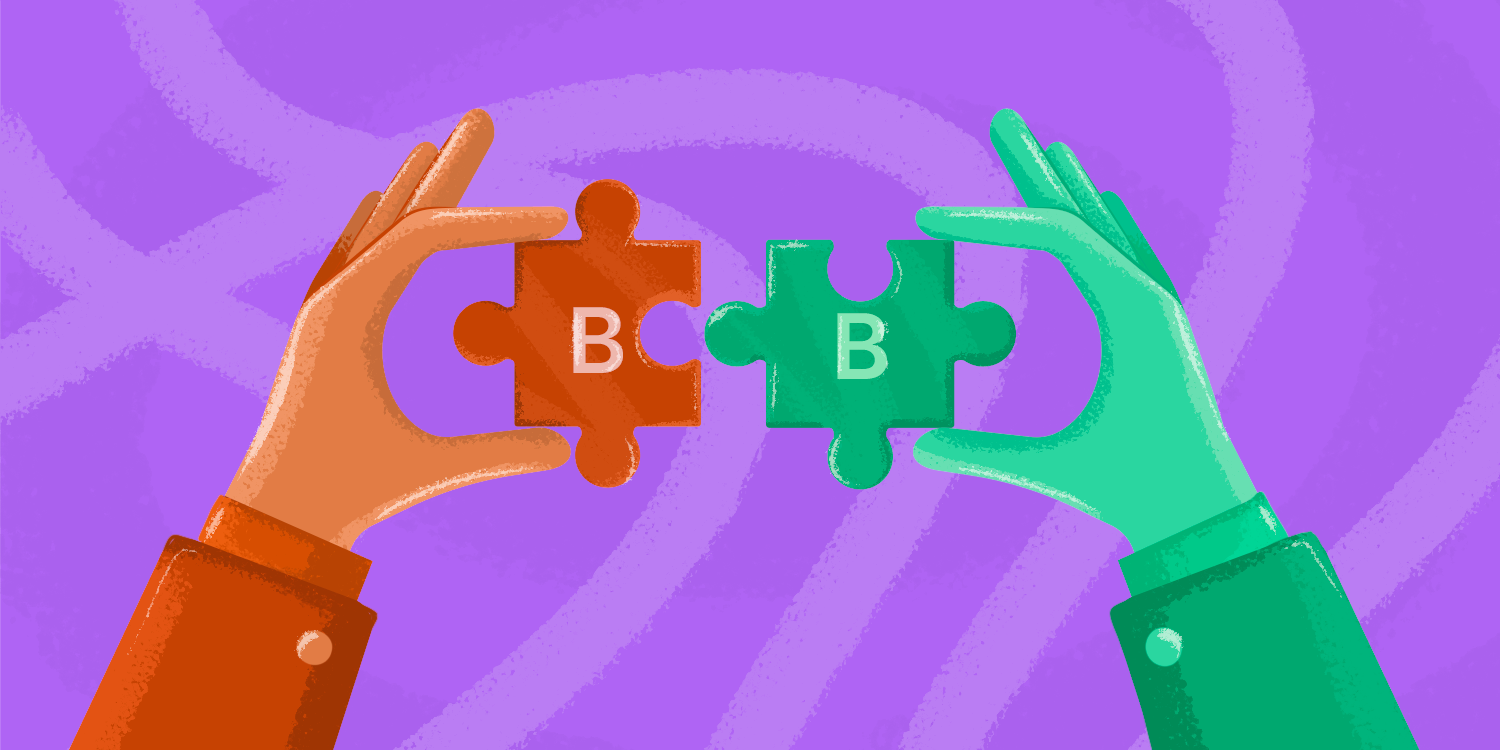B2B marketing… A phrase that often echoes in conference rooms and across digital networks, but if it’s still a murky concept for you, relax — it’s simpler than it sounds!
Let’s demystify B2B marketing, explore effective strategies for 2024, and look at real-world examples. Your journey to B2B marketing mastery begins here!
Outline:
What is B2B marketing?
B2B marketing, short for business-to-business marketing, involves one business marketing to other businesses, a dynamic quite different from selling to individual customers (found in B2C).
This area demands a specialized set of strategies and a deep understanding of your business clients’ specific needs. The ultimate aim? To forge enduring relationships, convert prospects into loyal customers, and propel your sales forward.
|
💡 Case Study: The Adobe Summit Conference To see B2B marketing in its finest form, let’s look at the Adobe Summit conference, an annual event where Adobe exhibits its digital marketing prowess, creating a platform for B2B marketing excellence through:
This example is more than a success story; it shows how B2B marketing can offer a fun, value-packed experience to its audience. The Adobe Summit shows how a brand can assert itself as a thought leader, educator, and collaborative partner in the B2B world, all while highlighting the value of Adobe’s offerings. |
While both B2B and B2C marketing aim to make customers happy, they also have some differences that set them apart. Let’s take a closer look!
What is the difference between B2B and B2C marketing?
The distinction between B2B and B2C marketing is quite straightforward, just like their names suggest: it’s all about their audiences and how they connect with them!
🛒B2C marketing revolves around understanding and fulfilling the desires, preferences, and daily needs of individual customers. It’s direct, personal, and often aims to create an emotional connection. Here are a couple of examples:
- Netflix: Netflix streams entertainment content directly to individual viewers, offering movies and TV shows for personal enjoyment.
- Starbucks: Starbucks provides a unique coffee shop experience to individual customers, whether they’re looking for relaxation, a social environment, or a workspace.
- Coca-Cola: Coca-Cola markets its beverages to individual consumers for personal refreshment.
💼B2B marketing focuses on meeting the needs, addressing pain points, and achieving the goals of businesses. The decision-making process here often involves multiple stakeholders with a focus on the organization’s needs and goals rather than individual preferences. Here are some prime examples:
- Snov.io: Snov.io caters to a range of businesses, from emerging startups to established corporations. It provides tools for B2B sales and marketing teams, enabling them to optimize lead generation, automate email outreach, and effectively manage and categorize leads through a robust marketing CRM.
- Cisco Systems: Cisco serves other businesses by offering key IT infrastructure components, such as routers, switches, and security solutions.
- Caterpillar: Caterpillar is a renowned manufacturer of heavy machinery and equipment for the construction, mining, and industrial sectors, with a primary focus on business needs in these industries.
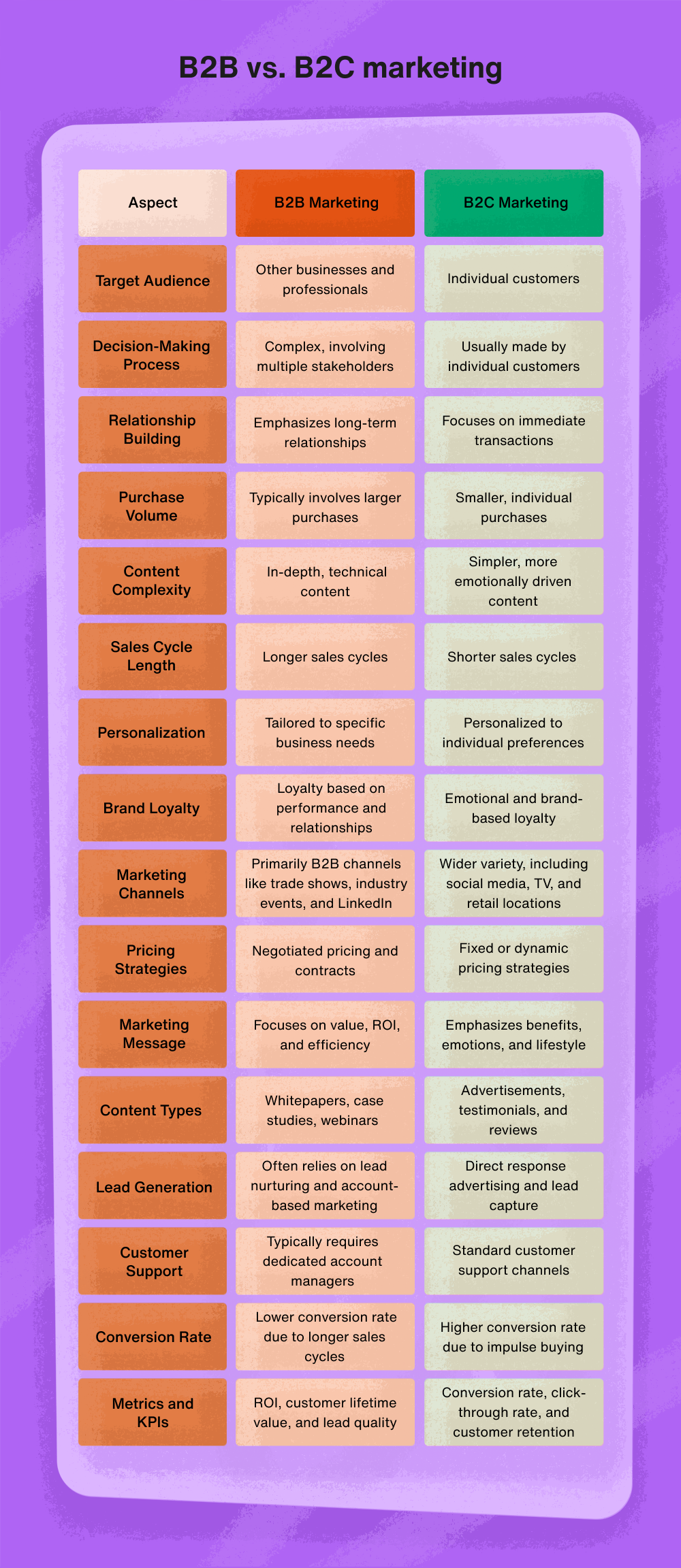
How does B2B marketing work?
Let’s start by delving into the B2B marketing funnel. It’ll help you understand what potential buyers go through before they make the decision to buy a new product. After that, we’ll explore the various approaches businesses take in B2B marketing.
The B2B marketing funnel explained
B2B marketing operates through a carefully structured process known as the B2B marketing funnel. This funnel represents the journey that potential buyers take from first learning about your product to becoming loyal customers and even brand advocates.
Let’s break down how this funnel works and its various stages:
- Awareness Stage (Top of Funnel – TOFU): This stage involves increasing brand visibility and attracting potential buyers. Common tactics include content marketing, social media engagement, search engine optimization (SEO), and advertising.
- Interest Stage (Middle of Funnel – MOFU): As prospects show interest, the marketing focus shifts to delivering valuable content and nurturing leads. This can include ebooks, webinars, case studies, and newsletters.
- Consideration Stage (Middle of Funnel – MOFU): Prospects actively evaluate their options at this stage, researching your offerings and comparing them with competitors. Content should be more in-depth, including product demos and customer testimonials.
- Decision Stage (Bottom of Funnel – BOFU): At the funnel’s bottom, prospects are close to making a purchase decision. Marketing should be precise, address specific concerns, and offer incentives like trials, discounts, or personalized proposals.
- Conversion Stage (Post-Purchase): Once a prospect becomes a customer, the focus shifts to seamless onboarding and building lasting relationships. This involves top-notch customer service and opportunities for upselling or cross-selling.
- Retention and Advocacy Stage (Post-Purchase): In this stage, happy customers become brand advocates. Encourage them to refer others, leave reviews, and engage in advocacy activities.
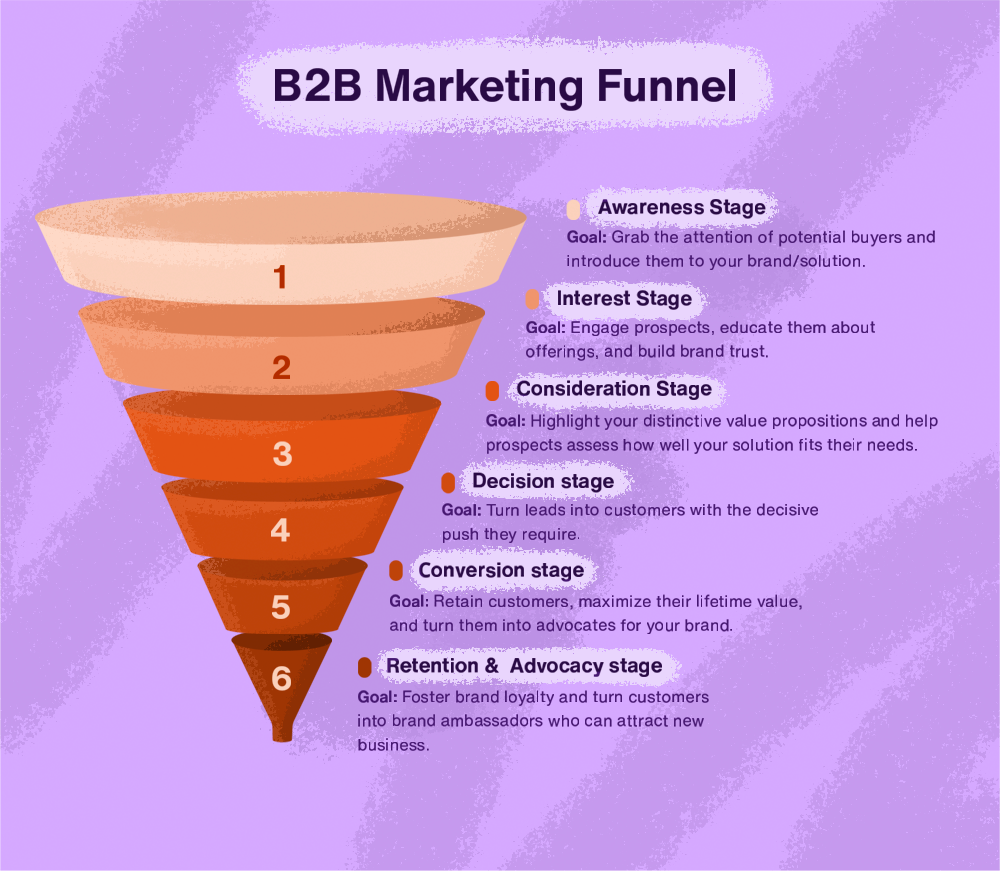
|
👀Hey, just a heads-up! A B2B marketing funnel isn’t a one-size-fits-all blueprint; its stages can flex and adapt based on your industry, product complexity, and the audience in focus! |
B2B marketing approaches
There are actually two different ways to go about B2B marketing: lead-based marketing and account-based marketing.
1. Lead-based marketing
Lead-based marketing in B2B is all about generating and nurturing potential business leads to convert them into customers. This approach is key for companies selling to other businesses. It involves identifying and targeting potential clients likely interested in what the company offers.
|
👀 Note! This approach aims to scoop up as many leads as possible, even if they’re not a perfect fit at first! |
Now, let’s dive into a short breakdown of what lead-based marketing covers.
- Target audience identification
Define your target audience and craft a detailed ideal customer profile (ICP) that reflects the characteristics, needs, and challenges of your potential customers. We’ve created an ICP template table for your convenience. Feel free to copy it for your purposes. Use the example we’ve provided in Column 2 as a guide.
| Ideal customer profile template | ||
| Factors | Example | Your ICP |
| Industry | B2B SaaS | |
| Location | USA, China, Canada | |
| Size | 50-10 employees | |
| Growth level | Startup | |
| Budget | $500-1500K | |
| Business objectives | -To grow their customer base 50% each coming year -To become the top web design service in 4 years |
|
| Pain points | -They don’t have a systematic approach to all business processes -Cold email outreach has a low reply rate -They have a relatively low brand awareness -Marketing and sales are not aligned |
|
| Decision-making factors | -They make decisions based on facts, testimonials, case studies -The decision-making is made by a team of top managers, not just by the CEO |
|
| Channels for outreach | LinkedIn, email | |
- Lead generation
The next step involves spotting and drawing in potential customers who’ve shown a spark of interest in what you offer. B2B marketers use everything in their toolkit for this, from content marketing and SEO to social media engagement, email outreach, eye-catching paid ads, and participation in trade shows.
|
😍Pro-tip! Life’s a lot easier with automated lead-generation tools! These solutions come with handy features like smart filters and web crawlers, allowing you to easily track down contacts and connect with prospects in your specific industry, role, or expertise area anywhere online. An option to consider is Snov.io’s Email Finder. With this user-friendly prospecting tool, you can easily discover email addresses, whether they’re hiding in company websites, professional profiles, search results, or even LinkedIn. And with a handy built-in Email Verifier, you won’t have to worry about the tedious task of manually verifying your prospects’ email addresses. All the contacts are pre-verified, ensuring that your email database stays constantly up-to-date! |
- Content marketing
Yes, yes, here comes perhaps the most overused word in all of marketing – “Content is king.” But there’s truth to it. In fact, 71% of B2B marketers stated that content marketing has become more important to their organization in the last year. Engaging content that tackles your audience’s pain points can draw in and connect with potential leads. So, get creative! - Website optimization and lead capture
Your company’s website should be easy to use, informative, and equipped with clear calls to action that encourage visitors to take that next step, be that filling out a contact form or grabbing a useful resource. These forms collect details like names, email addresses, job titles, and company info. - Lead qualification
Not every lead is the same, and that’s okay! Some are more likely to turn into paying customers than others. Lead qualification is like giving them a little test, looking at things like their budget, authority, need, and timeline (BANT). This helps you know which leads to give some extra love and care to! - Lead nurturing
Once you’ve got your leads and checked them out, the next fun part is nurturing them and ultimately moving them closer to a purchase decision. Companies excelling in lead nurturing produce 50% more sales-ready leads at 33% lower lead costs, so don’t miss your chance to join them.
- Lead management
CRM systems allow you to track and store lead information while ensuring seamless progression through the sales process. They also promote better collaboration between sales and marketing teams. And they’re just worth it! In 2021, the average ROI for CRM systems was around $30.48 for every dollar spent, a significant increase from the $8.71 ROI in 2014. - B2B sales & marketing alignment
Speaking of sales and marketing… They should be inseparable. Marketing generates and nurtures leads, while sales teams convert qualified leads into customers. The result? 36% higher customer retention rates!
2. Account-based marketing (ABM)
Account-based marketing (ABM) is a highly personalized strategy, ideal for B2B companies looking to treat each customer as an individual market.
Think of every account and buyer’s journey as a snowflake – no two are alike! When a B2B company adopts ABM, it’s like they’re choosing their dream clients and going the extra mile to win them over. They use tailor-made strategies for each chosen business to make it happen.
In ABM, the funnel starts with a narrower entry point because potential customers are theoretically closer to conversion than those that come in through a lead-based approach.
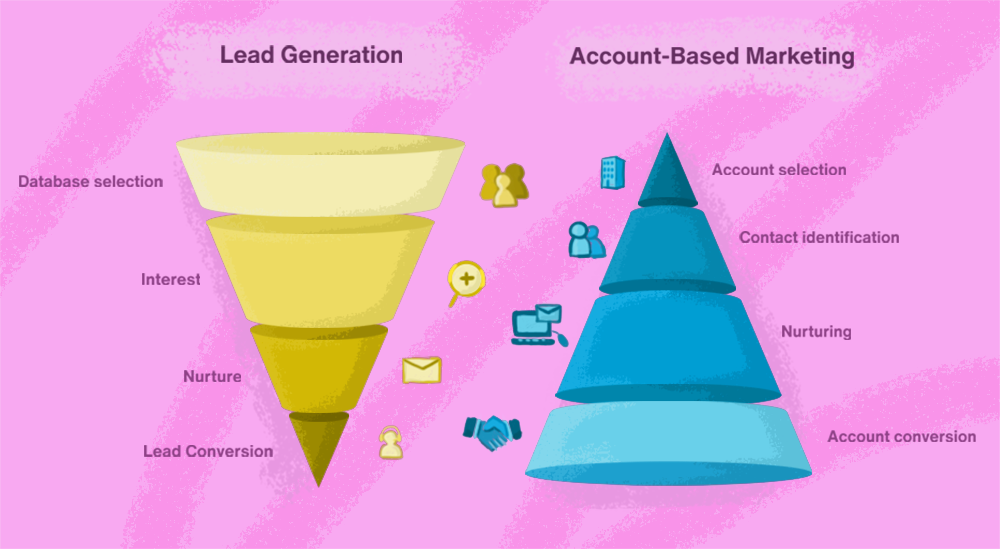
Here’s what ABM includes:
- Targeting the right accounts
First off, ABM requires pinpointing the ideal accounts you want to target. You can do this by looking at factors like revenue potential, industry relevance, product or service compatibility, and the account’s significance to your business strategy. - Account research
Once target accounts are chosen, thorough research is carried out to grasp the unique requirements, difficulties, and objectives of the account. This information serves as the foundation for crafting highly customized marketing strategies. - Creating personalized content
ABM involves developing personalized content for each target account, including customized emails, whitepapers, webinars, and other marketing materials that address the account’s unique pain points and interests. - Omni-channel marketing
ABM uses various marketing channels to connect with the chosen target accounts. This often includes B2B email marketing, social media campaigns, direct mail, and more, often integrated into a unified campaign. - Sales and marketing alignment: Again!
Companies with aligned ABM strategies have seen a 208% growth in their marketing revenue. Additionally, aligning these teams can improve deal-closing rates by 67%. - Technology and tools
An effective ABM strategy often requires the use of B2B marketing technologies, including CRM systems and analytics tools for monitoring and managing interactions with target accounts.
Examples of B2B marketing strategies
Now that you’ve got a good grasp of the general ideas behind B2B marketing let’s dive into specific strategies you can use to make your B2B marketing efforts shine.
B2B campaign marketing
Before you launch a campaign to promote your product or service, it requires careful planning. Most often, this is done through targeted email marketing.
Overall, email marketing is a reliable approach to connecting with both individual consumers and business clients. The majority of B2B marketers already harness the power of email – are you among them? If not, you should be. Emails pave the way for engagement, converting subscribers into potential leads and, eventually, happy customers.
Let’s explore a few reasons why adding email marketing to your B2B marketing strategy is a great idea:
- Direct communication: Email marketing enables direct, personalized interactions with prospective clients. It’s like having a one-on-one conversation, nurturing relationships, and building trust.
- Cost-effectiveness: In contrast to other B2B marketing strategies, it’s budget-friendly, offering impressive returns on investment.
- Targeted outreach: Segmenting your email lists lets you send messages directed at specific groups, increasing the likelihood of your message striking a chord with recipients.
- Lead generation: Emails allow you to provide both valuable content and compelling calls to action that motivate recipients to progress to the next stage of the sales funnel.
- Nurturing relationships: Email marketing is your channel to consistently deliver useful information, address client issues, and remain top-of-mind until they’re ready to commit.
- Analytics and optimization: Email marketing platforms come with robust analytics that allow you to track the performance of your campaigns and fine-tune your strategies based on what works best.
- Information sharing: B2B transactions often involve extensive information exchange. Email is perfect for sharing documents, proposals, and other critical data.
- Scalability: Whether you’re a startup or a large enterprise, email marketing adapts to your needs, making it incredibly versatile.
B2B email marketing example
Ready to launch your B2B marketing email? Follow these easy steps for a winning start:
Step #1 (Subject line)
Imagine starting your B2B email with a subject line that’s as captivating as the title of a favorite book or a thrilling movie. It’s the very first thing your recipient’s eyes will land on, so why not make it intriguing or even add a touch of playfulness?
Write something like…

Step #2 (Introduction)
Your introduction holds just as much importance as a catchy subject line! It welcomes your readers into your world, piques their interest, and makes them eager to explore what you have to share.

Step #3 (Problem identification)
In this section, emphasize with your recipient’s challenges. This approach not only shows your genuine concern for their needs but also lets you customize your message to tackle specific pain points. By doing this, you’ll likely build a stronger connection and provide solutions that hit home with your recipient.

Step #4 (Solution presentation)
After pinpointing a challenge, it’s time to reveal your product. This shift demonstrates your role as not just an observer of pain points but a provider of solutions.

Step #5 (Highlighting the benefits)
Now, let’s paint a picture of the tangible benefits your solution offers. Vivid, real-life examples make your solution relatable and desirable.

Step #6 (Сase study mentioning)
Sharing a success story of how your solution has benefited others adds credibility and helps your audience better visualize how it can positively transform their own business.

Step #7 (Call to action)
Now that your recipients are feeling enthusiastic, why not gently guide them with a friendly call to action?

⚠️Remember, it’s better to stick to one call to action per email!
Step #8 (Contact information)
Providing your contact details adds a personal and accessible touch. Make it easy for recipients to reach out with any queries or further discussions.

👀Extra tips
- Follow up! If you don’t hear back within a week, send a follow-up email. Maybe try, ’Hey there! Just checking in about our previous message. Have you had a chance to think about our software solutions?’
- Personalize! Address recipients by name and include details specific to their company. This shows you’ve taken the time to get to know them and understand their unique needs.
- Track & analyze! Use email marketing automation tools to keep an eye on open, click-through, and conversion rates. Analyzing this data, you can tweak your strategies for even better results.
B2B digital marketing
In both B2B and B2C worlds, a strong online presence makes the difference! We’re talking about the power of social media, Google ads, text messaging, influencer marketing, SEO, and all those other digital spaces where your B2B company shines.
In 2024, a noticeable absence on social media could even dent your trust factor with customers. Hence, B2B digital marketing is the key to boosting your brand’s visibility, conveying the awesomeness of your product or service, and, best of all, turning more of your audience into happy customers!
Let’s dive into a few B2B digital marketing strategies that you can put to work to boost your revenue:
- Define your brand’s positioning: Brand positioning is like finding your business’s special place in your customers’ hearts and minds. It’s all about making sure you stand out from the crowd so people remember you in a snap. Strong positioning allows you to market more effectively and craft messages that resonate deeply with your audience.
- Get to know your target audience: Start by identifying your perfect customers genuinely interested in what you offer. If you have a helpful tool like Snov.io’s Sales CRM at your disposal, it’s time to dig into your client information! These personas are foundational, influencing your digital marketing strategies by providing insights into your customers’ challenges and solution-seeking behaviors.
- Create a user-friendly B2B website: Make a fantastic impression on your customers with a website that’s not just well-designed but chock-full of useful information. When planning your site’s content, keep your buyer personas in mind – think about what they need and the challenges they face. A user-friendly website is easy to navigate, responsive on various devices, and mobile-friendly.
|
⚠️Attention! Can your visitors easily spot and tap on your calls to action, especially when they’re browsing on their mobile devices? Make sure you’re paying attention to your site’s loading speed so that your customers don’t end up feeling frustrated and deciding to leave. |
- Forge meaningful connections through social media marketing: 75% of B2B buyers check out social media before making a purchase. So, why not set up a social media page for your business on the platforms your B2B customers prefer? You can have fun promoting your website and repurpose your content into snappy videos and shareable infographics.
- Elevate your online presence with SEO: A solid 33% of B2B companies have recognized SEO as their primary lead generation tool! With a strong SEO strategy, your website can rank high in search results, making it easy for potential customers to discover your products and services.
- Consider running PPC ads: Engaging in PPC advertising is a fantastic way to get your message and brand in front of the people who matter most to you on search engines, social media, and other advertising platforms. Plus, it’s a terrific method for collecting valuable first-hand information about your leads!
B2B digital marketing example: Snov.io
Snov.io’s homepage is a testament to its user-friendly design, perfectly catering to its customer’s needs. The first thing visitors see is a compelling message: ‘More Leads. More Sales. More Revenue.’ This succinctly captures the essence of what Snov.io offers and appeals directly to B2B businesses looking to grow.
Moreover, Snov.io’s website is equipped with two inviting buttons: one for free exploration of their services and another offering a detailed demo. This approach not only showcases Snov.io’s tools but also demonstrates their understanding of customer needs, making the site both informative and engaging.
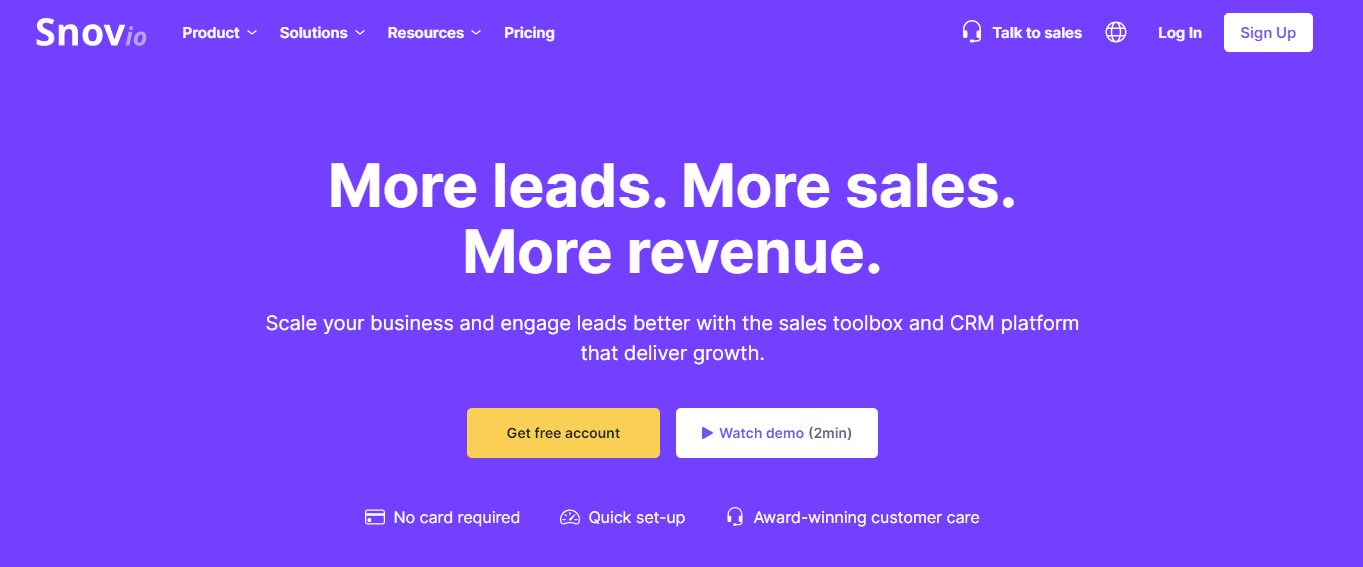
B2B content marketing
Effective B2B marketing hinges on engaging content. Imagine creating a blend of blog posts, white papers, case studies, and videos that not only inform but also resonate with your B2B audience. This strategy moves beyond conventional sales pitches, focusing instead on providing valuable insights and solutions.
The beauty of content marketing lies in its ability to engage. It’s about understanding your audience’s questions and challenges and presenting your business as a source of answers and assistance.
Additionally, well-crafted content bolsters your SEO efforts. By aligning with what your audience is searching for, you guide them to your website, where they find helpful information and learn more about your offerings.
|
📢 Pro-tip: Develop content that supports the entire customer journey, from sparking initial curiosity to aiding their decision-making process. |

B2B content marketing example: HubSpot Academy
HubSpot Academy, brought to you by the leading inbound marketing company HubSpot, is a fantastic example of B2B content marketing that’s both informative and engaging.
This platform provides a wide range of free courses covering topics in marketing, sales, and customer service. What makes it truly stand out is the opportunity to earn industry-recognized certifications, which can significantly boost your professional profile.
What’s particularly impressive is that HubSpot keeps its courses up-to-date to keep pace with the ever-evolving world of digital marketing. They also foster an active online community where you can engage in discussions and learn from your peers.
In a subtle but effective way, these courses also demonstrate the practical use of HubSpot’s software tools. The results? Increased brand loyalty, lead generation, and enhanced industry recognition. HubSpot Academy’s approach beautifully showcases how delivering value can create loyalty, generate leads, and establish credibility in the industry.
Wrapping up
By embracing B2B marketing, you’re opening the door to directly connect with your ideal audience, refine your strategies using data-driven insights, and set the stage for long-lasting business expansion.
And here’s the exciting part: happy clients, thanks to effective B2B marketing, often become your biggest fans. They not only bring in steady income but also happily recommend your business to others.
So, why not give your business a turbo boost in 2024 and beyond? Consider this guide your friendly companion whenever you need a bit of direction!
